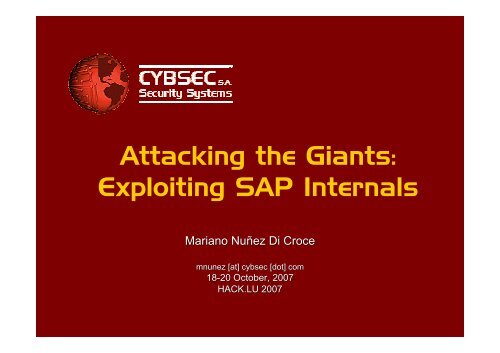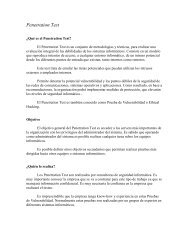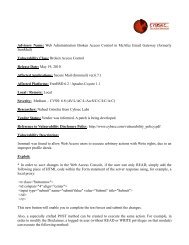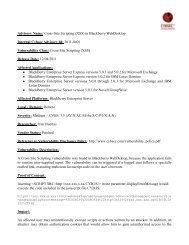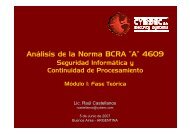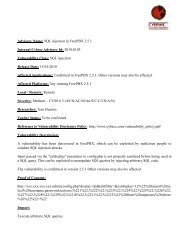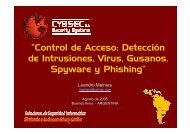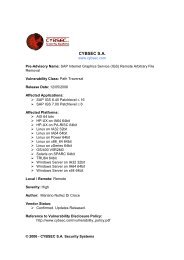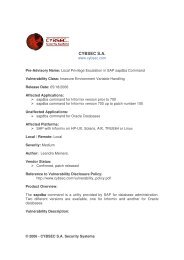Attacking the Giants: Exploiting SAP Internals - Cybsec
Attacking the Giants: Exploiting SAP Internals - Cybsec
Attacking the Giants: Exploiting SAP Internals - Cybsec
You also want an ePaper? Increase the reach of your titles
YUMPU automatically turns print PDFs into web optimized ePapers that Google loves.
<strong>Attacking</strong> <strong>the</strong> <strong>Giants</strong>:<br />
<strong>Exploiting</strong> <strong>SAP</strong> <strong>Internals</strong><br />
Mariano Nuñez Di Croce<br />
mnunez [at] cybsec [dot] com<br />
18-20 October, 2007<br />
HACK.LU 2007
<strong>Attacking</strong> <strong>the</strong> <strong>Giants</strong>: <strong>Exploiting</strong> <strong>SAP</strong> <strong>Internals</strong><br />
© 2007<br />
Agenda<br />
• <strong>SAP</strong> Connectivity<br />
• <strong>SAP</strong> RFC Interface<br />
•The RFC Library<br />
• Security Review of <strong>the</strong> RFC Interface Implementation<br />
• PenTesting with sapyto<br />
• Going After <strong>the</strong> Low-Hanging-Fruit<br />
• Advanced Attacks<br />
•Conclusions<br />
• Questions & Answers<br />
2
<strong>Attacking</strong> <strong>the</strong> <strong>Giants</strong>: <strong>Exploiting</strong> <strong>SAP</strong> <strong>Internals</strong><br />
© 2007<br />
<strong>SAP</strong> Connectivity<br />
3
<strong>Attacking</strong> <strong>the</strong> <strong>Giants</strong>: <strong>Exploiting</strong> <strong>SAP</strong> <strong>Internals</strong><br />
<strong>SAP</strong> Connectivity<br />
© 2007<br />
<strong>SAP</strong> Connectivity<br />
• <strong>SAP</strong> is designed to be able to interact with many external systems.<br />
• This way you can integrate and centralize information under a<br />
unique architecture.<br />
• Communicating with o<strong>the</strong>r systems:<br />
•ALE<br />
•EDI<br />
• HTTP<br />
• RFC<br />
•FTP<br />
•XML<br />
•SMTP<br />
•…<br />
4
<strong>Attacking</strong> <strong>the</strong> <strong>Giants</strong>: <strong>Exploiting</strong> <strong>SAP</strong> <strong>Internals</strong><br />
© 2007<br />
<strong>SAP</strong> RFC<br />
Interface<br />
5
<strong>Attacking</strong> <strong>the</strong> <strong>Giants</strong>: <strong>Exploiting</strong> <strong>SAP</strong> <strong>Internals</strong><br />
<strong>SAP</strong> RFC Interface<br />
© 2007<br />
A Little Bit of History...<br />
• In <strong>the</strong> beginning, <strong>SAP</strong> implemented IBM´s CPI-C interface to<br />
communicate with o<strong>the</strong>r systems.<br />
• CPI-C was developed to allow data transfer.<br />
• Complex applications needed to be able to call functions on o<strong>the</strong>r<br />
servers.<br />
•Result: <strong>SAP</strong> Remote Function Call (RFC) Interface.<br />
• Developed in <strong>the</strong> 1980s, based on CPI-C.<br />
• Today, <strong>the</strong> RFC Interface is a key component of <strong>the</strong> <strong>SAP</strong> Application<br />
Server.<br />
6
<strong>Attacking</strong> <strong>the</strong> <strong>Giants</strong>: <strong>Exploiting</strong> <strong>SAP</strong> <strong>Internals</strong><br />
<strong>SAP</strong> RFC Interface<br />
© 2007<br />
<strong>SAP</strong> Systems Layout<br />
7
<strong>Attacking</strong> <strong>the</strong> <strong>Giants</strong>: <strong>Exploiting</strong> <strong>SAP</strong> <strong>Internals</strong><br />
<strong>SAP</strong> RFC Interface<br />
© 2007<br />
RFC Function Modules<br />
•For a Function Module to be remotely-callable, it must be flagged as<br />
"Remote-enabled".<br />
• ABAP Programs call a remote Function Module using <strong>the</strong> command<br />
CALL FUNCTION...DESTINATION..<br />
...<br />
CALL FUNCTION ‘ZCUST_GETMONEY’ DESTINATION ‘PROD2’<br />
EXPORTING<br />
ZCUST_ID = 100<br />
IMPORTING<br />
MONEY = cust_money<br />
TABLES<br />
TABINFO = table1<br />
EXCEPTIONS<br />
CUST_NOT_FOUND = 0<br />
TABLE_EMPTY = 1<br />
...<br />
8
<strong>Attacking</strong> <strong>the</strong> <strong>Giants</strong>: <strong>Exploiting</strong> <strong>SAP</strong> <strong>Internals</strong><br />
<strong>SAP</strong> RFC Interface<br />
© 2007<br />
RFC Destinations<br />
DESTINATION argument is a index key to an RFC Destinations table<br />
(RFCDES), maintained through transaction SM59.<br />
9
<strong>Attacking</strong> <strong>the</strong> <strong>Giants</strong>: <strong>Exploiting</strong> <strong>SAP</strong> <strong>Internals</strong><br />
<strong>SAP</strong> RFC Interface<br />
© 2007<br />
The Gateway Service<br />
• CPIC/RFC communication is done through <strong>the</strong> Gateway Service.<br />
• Handles communications between <strong>SAP</strong> systems and between <strong>SAP</strong><br />
systems and External systems.<br />
• Logically, it consists of three different services.<br />
Gateway Server<br />
Gateway Reader<br />
Gateway<br />
Work Process<br />
Gateway Monitor<br />
TCP/IP LU 6.2<br />
External Program<br />
External Program<br />
Administration<br />
10
<strong>Attacking</strong> <strong>the</strong> <strong>Giants</strong>: <strong>Exploiting</strong> <strong>SAP</strong> <strong>Internals</strong><br />
<strong>SAP</strong> RFC Interface<br />
© 2007<br />
RFC Between <strong>SAP</strong> and External Systems<br />
• External RFC Client<br />
• External RFC Server<br />
External System<br />
<strong>SAP</strong> R/3 System<br />
<strong>SAP</strong> R/3 System<br />
External System<br />
Client<br />
Program<br />
Values<br />
G<br />
A<br />
T<br />
ABAP<br />
Function<br />
Module<br />
ABAP<br />
Program<br />
G<br />
A<br />
T<br />
Values<br />
Result<br />
Server Function 1<br />
E<br />
E<br />
Result<br />
W<br />
A<br />
Y<br />
result<br />
W<br />
A<br />
Y<br />
Server Function 2<br />
11
<strong>Attacking</strong> <strong>the</strong> <strong>Giants</strong>: <strong>Exploiting</strong> <strong>SAP</strong> <strong>Internals</strong><br />
<strong>SAP</strong> RFC Interface<br />
© 2007<br />
External RFC Servers<br />
•2 Ways of "attaching" External RFC Servers:<br />
• Started Mode<br />
• Application Server starts <strong>the</strong>m remotely on-demand.<br />
• Commonly via Remote Shell or Remote Exec (!)<br />
• External Server is closed after operation.<br />
• Registered Mode<br />
• External Server registers itself at <strong>the</strong> Gateway Server.<br />
• Identified by a Program ID.<br />
• External Server is not closed.<br />
But ... How do you develop an external client / server ??<br />
12
<strong>Attacking</strong> <strong>the</strong> <strong>Giants</strong>: <strong>Exploiting</strong> <strong>SAP</strong> <strong>Internals</strong><br />
© 2007<br />
The RFC Library<br />
13
<strong>Attacking</strong> <strong>the</strong> <strong>Giants</strong>: <strong>Exploiting</strong> <strong>SAP</strong> <strong>Internals</strong><br />
The RFC Library<br />
© 2007<br />
The RFC Library<br />
"The RFC Library is <strong>the</strong> most commonly used and<br />
installed component of existing <strong>SAP</strong> software”<br />
<strong>SAP</strong> RFCSDK Guide<br />
• API released by <strong>SAP</strong> to allow development of external RFC<br />
clients/servers.<br />
• Available for all <strong>SAP</strong> supported platforms.<br />
• An upper layer: JCo, .Net, ...<br />
• Nice documentation.<br />
• Delivered with examples.<br />
14
<strong>Attacking</strong> <strong>the</strong> <strong>Giants</strong>: <strong>Exploiting</strong> <strong>SAP</strong> <strong>Internals</strong><br />
The RFC Library<br />
© 2007<br />
External RFC Server <strong>Internals</strong><br />
• First of all, <strong>the</strong> server install available functions:<br />
RfcInstallFunction(RFC_FUNCTIONNAME functionname,<br />
RFC_ONCALL f_ptr,<br />
rfc_char_t *docu);<br />
• Listen and dispatch requests with RfcDispatch() loop.<br />
• Requested function (f_ptr) is executed.<br />
• Results are sent back to client.<br />
• Three functions installed by default:<br />
•RFC_DOCU<br />
•RFC_PING<br />
• RFC_SYSTEM_INFO<br />
15
<strong>Attacking</strong> <strong>the</strong> <strong>Giants</strong>: <strong>Exploiting</strong> <strong>SAP</strong> <strong>Internals</strong><br />
© 2007<br />
Security Review<br />
of <strong>the</strong> RFC<br />
Interface<br />
Implementation<br />
(version 6.40)<br />
16
<strong>Attacking</strong> <strong>the</strong> <strong>Giants</strong>: <strong>Exploiting</strong> <strong>SAP</strong> <strong>Internals</strong><br />
Security Review of <strong>the</strong> RFC Interface...<br />
© 2007<br />
Traffic Analysis<br />
• Information is sent in clear-text by default.<br />
•<strong>SAP</strong> provides SNC (Secure Network Communications) for<br />
encryption of traffic.<br />
•What can we get?<br />
• Logon information.<br />
• Called Function Name.<br />
• Parameters Information and Content.<br />
• Tables Information and Content (may be compressed).<br />
• Client and Server information.<br />
• ...<br />
17
<strong>Attacking</strong> <strong>the</strong> <strong>Giants</strong>: <strong>Exploiting</strong> <strong>SAP</strong> <strong>Internals</strong><br />
Security Review of <strong>the</strong> RFC Interface...<br />
© 2007<br />
Traffic Analysis<br />
...<br />
01a0 00 00 00 00 00 00 06 05 14 00 10 5f 22 ea 45 5e ..........._".E^<br />
01b0 22 c5 10 e1 00 00 00 c0 a8 02 8b 05 14 01 30 00 ".............0.<br />
01c0 0a 72 66 63 5f 73 65 72 76 65 72 01 30 01 11 00 .rfc_server.0...<br />
01d0 06 42 43 55 53 45 52 01 11 01 17 00 0b 81 bb 89 .BCUSER.........<br />
01e0 62 fc b5 3e 70 07 6e 79 01 17 01 14 00 03 30 30 b..?w.oy......00<br />
01f0 30 01 14 01 15 00 01 45 01 15 05 01 00 01 01 05 0......E........<br />
0200 01 05 02 00 00 05 02 00 0b 00 03 36 34 30 00 0b ...........640..<br />
0210 01 02 00 0e 5a 43 55 53 54 5f 47 45 54 4d 4f 4e ....ZCUST_GETMON<br />
0220 45 59 01 02 05 14 00 10 5f 22 ea 45 5e 22 c5 10 EY......_".E^"..<br />
0230 e1 00 00 00 c0 a8 02 8b 05 14 02 01 00 09 43 4c ..............CL<br />
0240 49 45 4e 54 5f 49 44 02 01 02 03 00 08 43 55 53 IENT_ID......CUS<br />
0250 54 30 30 31 00 02 03 ff ff 00 00 ff ff 00 00 01 T001............<br />
0260 c7 00 00 3e 80 ...>.<br />
18
<strong>Attacking</strong> <strong>the</strong> <strong>Giants</strong>: <strong>Exploiting</strong> <strong>SAP</strong> <strong>Internals</strong><br />
Security Review of <strong>the</strong> RFC Interface...<br />
© 2007<br />
Traffic Analysis: Show me <strong>the</strong> Password!<br />
• You said that data is clear-text... but I can’t see a single password!<br />
•Reason: Password is obfuscated.<br />
for each CHAR in CLEAR_TEXT_PASS<br />
OBFUSCATED_PASS[i] = CHAR XOR KEY[i]<br />
KEY_TO_THE_KINGDOM = [0x96, 0xde, 0x51, 0x1e, 0x74, 0xe,<br />
0x9, 0x9, 0x4, 0x1b, 0xd9, 0x46, 0x3c, 0x35, 0x4d, 0x8e,<br />
0x55, 0xc5, 0xe5, 0xd4, 0xb, 0xa0, 0xdd, 0xd6, 0xf5,<br />
0x21, 0x32, 0xf, 0xe2, 0xcd, 0x68, 0x4f, 0x1a, 0x50,<br />
0x8f, 0x75, 0x54, 0x86, 0x3a, 0xbb]<br />
19
<strong>Attacking</strong> <strong>the</strong> <strong>Giants</strong>: <strong>Exploiting</strong> <strong>SAP</strong> <strong>Internals</strong><br />
Security Review of <strong>the</strong> RFC Interface...<br />
© 2007<br />
Function Analysis: RFC_DOCU<br />
• Retrieves documentation about installed functions on External<br />
Server.<br />
• Specifically, it outputs strings defined in <strong>the</strong> rfc_docu parameter of<br />
RfcInstallFunction() calls.<br />
• No need for valid logon data.<br />
• Available in External Systems.<br />
This function can be used to discover installed functions and <strong>the</strong>ir<br />
structure.<br />
20
<strong>Attacking</strong> <strong>the</strong> <strong>Giants</strong>: <strong>Exploiting</strong> <strong>SAP</strong> <strong>Internals</strong><br />
Security Review of <strong>the</strong> RFC Interface...<br />
© 2007<br />
Function Analysis: RFC_PING<br />
•An RFC ping<br />
• Connects to <strong>the</strong> target system, analyzing its availability.<br />
• No need for valid logon data.<br />
• Available in External Systems and <strong>SAP</strong> Application Servers.<br />
This function can be used to check for availability of a remote RFC<br />
Server.<br />
21
<strong>Attacking</strong> <strong>the</strong> <strong>Giants</strong>: <strong>Exploiting</strong> <strong>SAP</strong> <strong>Internals</strong><br />
Security Review of <strong>the</strong> RFC Interface...<br />
© 2007<br />
Function Analysis: RFC_SYSTEM_INFO<br />
• Obtain RFC server system information.<br />
• No need for logon data!<br />
• Available in External Systems and <strong>SAP</strong> Application Servers (!).<br />
What can we get?<br />
• <strong>SAP</strong> Kernel Version<br />
•Hostname<br />
•Timezone<br />
• Database Engine<br />
• Database Host<br />
•<strong>SAP</strong> System ID<br />
• Operating System<br />
• ...<br />
22
<strong>Attacking</strong> <strong>the</strong> <strong>Giants</strong>: <strong>Exploiting</strong> <strong>SAP</strong> <strong>Internals</strong><br />
Security Review of <strong>the</strong> RFC Interface...<br />
© 2007<br />
Some O<strong>the</strong>r Functions<br />
There are o<strong>the</strong>r functions installed by default in every external RFC<br />
server. We have discovered security vulnerabilities in some of <strong>the</strong>m:<br />
• RFC_TRUSTED_SYSTEM_SECURITY<br />
• RFC_SET_REG_SERVER_PROPERTY<br />
• RFC_START_GUI<br />
• SYSTEM_CREATE_INSTANCE<br />
• RFC_START_PROGRAM<br />
The thing is that…any of this functions can be called, just as regular<br />
installed functions...<br />
23
<strong>Attacking</strong> <strong>the</strong> <strong>Giants</strong>: <strong>Exploiting</strong> <strong>SAP</strong> <strong>Internals</strong><br />
Security Review of <strong>the</strong> RFC Interface...<br />
© 2007<br />
Abusing Default Functions<br />
• RFC_TRUSTED_SYSTEM_SECURITY<br />
Check existence of users and groups in an External system, its<br />
domain and trusted domains.<br />
• RFC_SET_REG_SERVER_PROPERTY<br />
Denial Of Service of Registered Servers.<br />
• RFC_START_GUI<br />
Remote Command Execution (buffer overflow).<br />
24
<strong>Attacking</strong> <strong>the</strong> <strong>Giants</strong>: <strong>Exploiting</strong> <strong>SAP</strong> <strong>Internals</strong><br />
Security Review of <strong>the</strong> RFC Interface...<br />
© 2007<br />
Abusing Default Functions (cont.)<br />
• SYSTEM_CREATE_INSTANCE<br />
Remote Command Execution (buffer overflow).<br />
• RFC_START_PROGRAM<br />
Restricted through RfcAllowStartProgram(“progname“)<br />
Remote Command Execution (buffer overflow).<br />
Determine Applied Restrictions through RfcAllowStartProgram().<br />
Path Traversal Attacks (c:\path\IamAllowed.exe\..\butIamNot.exe).<br />
25
<strong>Attacking</strong> <strong>the</strong> <strong>Giants</strong>: <strong>Exploiting</strong> <strong>SAP</strong> <strong>Internals</strong><br />
© 2007<br />
PenTesting with<br />
sapyto<br />
26
<strong>Attacking</strong> <strong>the</strong> <strong>Giants</strong>: <strong>Exploiting</strong> <strong>SAP</strong> <strong>Internals</strong><br />
PenTesting with sapyto<br />
© 2007<br />
sapyto<br />
•Firstpublic framework for performing <strong>SAP</strong> Penetration Tests.<br />
• Core dependencies: <strong>SAP</strong> RFC Library and saprfc module.<br />
• Plugin based.<br />
• Shipped with plugins for analyzing RFC vulnerabilities,<br />
auditing <strong>SAP</strong> R/3 configuration, perform <strong>the</strong> actual penetration, etc..<br />
• Developed in Python and C.<br />
Download -><br />
http://www.cybsec.com/en/research/defau<br />
27
<strong>Attacking</strong> <strong>the</strong> <strong>Giants</strong>: <strong>Exploiting</strong> <strong>SAP</strong> <strong>Internals</strong><br />
PenTesting with sapyto<br />
© 2007<br />
Available Plugins in Beta Version<br />
•Audit:<br />
•RFC Ping.<br />
• Registration of External Servers.<br />
• Detection of RFCEXEC.<br />
• Detection of <strong>SAP</strong>XPG.<br />
• Get system information.<br />
• Get server documentation.<br />
28
<strong>Attacking</strong> <strong>the</strong> <strong>Giants</strong>: <strong>Exploiting</strong> <strong>SAP</strong> <strong>Internals</strong><br />
PenTesting with sapyto<br />
© 2007<br />
Available Plugins in Beta Version (cont.)<br />
•Attack:<br />
• RFC_START_PROGRAM Directory Trasversal.<br />
• Run commands through RFCEXEC.<br />
• Run commands through <strong>SAP</strong>XPG.<br />
• StickShell.<br />
• Evil Twin Attack.<br />
• Get remote RFCShell.<br />
• Tools:<br />
• RFC Password Obfuscator / De-obfuscator.<br />
29
<strong>Attacking</strong> <strong>the</strong> <strong>Giants</strong>: <strong>Exploiting</strong> <strong>SAP</strong> <strong>Internals</strong><br />
© 2007<br />
Going<br />
After <strong>the</strong><br />
Low-Hanging Fruit<br />
30
<strong>Attacking</strong> <strong>the</strong> <strong>Giants</strong>: <strong>Exploiting</strong> <strong>SAP</strong> <strong>Internals</strong><br />
Going After <strong>the</strong> Low-Hanging Fruit<br />
© 2007<br />
RFCEXEC<br />
•Bundledwith<strong>the</strong>RFCSDK.<br />
•Works in registered mode.<br />
• Released as an example, not intended for productive use.<br />
• Provides <strong>the</strong> following functions:<br />
• RFC_RAISE_ERROR<br />
•RFC_MAIL<br />
• RFC_REMOTE_PIPE<br />
• RFC_REMOTE_FILE<br />
• RFC_REMOTE_EXEC<br />
• Protected through rfcexec.sec file directives.<br />
31
<strong>Attacking</strong> <strong>the</strong> <strong>Giants</strong>: <strong>Exploiting</strong> <strong>SAP</strong> <strong>Internals</strong><br />
Going After <strong>the</strong> Low-Hanging Fruit<br />
© 2007<br />
<strong>SAP</strong>XPG<br />
• Executable shipped with <strong>SAP</strong> Application Server.<br />
•Works in started mode.<br />
• Started programs restricted through <strong>the</strong> sec_info file.<br />
• Used for execution of external commands and programs.<br />
• Installs <strong>the</strong> following functions:<br />
• <strong>SAP</strong>XPG_END_XPG<br />
• <strong>SAP</strong>XPG_START_XPG_LONG<br />
• <strong>SAP</strong>XPG_START_XPG<br />
So…what if we tell <strong>the</strong> Gateway to start sapxpg?<br />
32
<strong>Attacking</strong> <strong>the</strong> <strong>Giants</strong>: <strong>Exploiting</strong> <strong>SAP</strong> <strong>Internals</strong><br />
© 2007<br />
Advanced<br />
Attacks<br />
33
<strong>Attacking</strong> <strong>the</strong> <strong>Giants</strong>: <strong>Exploiting</strong> <strong>SAP</strong> <strong>Internals</strong><br />
Advanced Attacks<br />
© 2007<br />
Attacks Setup<br />
• Scenario:<br />
• We need some information about current deployment.<br />
• How do we get it?<br />
• Network sniffing (RFC is clear-text!).<br />
• The Gateway Monitor.<br />
• Kidnapping an <strong>SAP</strong> administrator. (No step-by-step<br />
demonstration )<br />
34
<strong>Attacking</strong> <strong>the</strong> <strong>Giants</strong>: <strong>Exploiting</strong> <strong>SAP</strong> <strong>Internals</strong><br />
Advanced Attacks<br />
© 2007<br />
Getting <strong>the</strong> Information: The Gateway Monitor<br />
•TheGateway Server has a configuration parameter for restricting<br />
Gateway Monitor access.<br />
gw/monitor = 0<br />
gw/monitor = 1<br />
gw/monitor = 2<br />
Monitor is disabled.<br />
Local access only.<br />
Remote access enabled.<br />
• Up to <strong>SAP</strong> Kernels 6.20, default value for this parameter is: 2.<br />
• Remote access to <strong>the</strong> Gateway Monitor would provide any<br />
information needed for <strong>the</strong> attacks.<br />
35
<strong>Attacking</strong> <strong>the</strong> <strong>Giants</strong>: <strong>Exploiting</strong> <strong>SAP</strong> <strong>Internals</strong><br />
Advanced Attacks<br />
© 2007<br />
Evil Twin<br />
• Registration of External Servers can be done remotely.<br />
• ACL for registration process is implemented through <strong>the</strong> reg_info file.<br />
•By default, registration for everyone is allowed. (Registration Party!)<br />
• External Servers can register several times with <strong>the</strong> same Program ID.<br />
• ANY External Server can register with that ID!<br />
•Attack:<br />
1. Connect to licit Registered Server, ID=REG1 (blocking<br />
connections).<br />
2. Register External Server with ID=REG1.<br />
3. Drink some beer while watching calls arriving to our Evil Twin<br />
Server...<br />
36
<strong>Attacking</strong> <strong>the</strong> <strong>Giants</strong>: <strong>Exploiting</strong> <strong>SAP</strong> <strong>Internals</strong><br />
Advanced Attacks<br />
© 2007<br />
Evil Twin illustrated…<br />
RESPONSE<br />
ID=REG1<br />
RCF Call<br />
<strong>SAP</strong> GW<br />
ID=REG1<br />
<strong>SAP</strong> R/3<br />
- Legimate An Now, external <strong>the</strong> External same RFC malicious RFC Server client/server registers connects at appears <strong>SAP</strong> R/3 with in Gateway. <strong>the</strong><br />
-scene... <strong>SAP</strong> Innocent R/3 Gateway, (don’t lamb connection be registering afraid, establishment...<br />
it’s itself controlled) with <strong>the</strong> same ID as <strong>the</strong><br />
-original Client The attacker performs external connects RFC server call with and <strong>the</strong> Server original answers RFC server, politely.<br />
-preventing All future him connections from serving to <strong>the</strong> requests REG1 from server o<strong>the</strong>r will clients. be attended<br />
by <strong>the</strong> evil one.<br />
External RFC<br />
Malicius Server<br />
37
<strong>Attacking</strong> <strong>the</strong> <strong>Giants</strong>: <strong>Exploiting</strong> <strong>SAP</strong> <strong>Internals</strong><br />
Advanced Attacks<br />
© 2007<br />
A Wiser (and Stealth) Evil Twin: MITM Attacks<br />
• Proof of Concept.<br />
•Attack:<br />
1. Connect to licit Registered Server, ID=REG1 (blocking connections).<br />
2. Register External Server with ID=REG1.<br />
3. Receive RFC call.<br />
4. Log / Modify Parameters values.<br />
5. Use established connection with licit Registered Server to forward<br />
<strong>the</strong> (possible modified) RFC call.<br />
6. Get results and send <strong>the</strong>m to <strong>the</strong> original client.<br />
7. Disconnect from <strong>the</strong> licit Registered Server.<br />
8. Back to Step 1.<br />
38
<strong>Attacking</strong> <strong>the</strong> <strong>Giants</strong>: <strong>Exploiting</strong> <strong>SAP</strong> <strong>Internals</strong><br />
Advanced Attacks<br />
© 2007<br />
A Wiser (and Stealth) Evil Twin: MITM Attacks<br />
RESPONSE<br />
ID=REG1<br />
RCF Call<br />
<strong>SAP</strong> R/3<br />
<strong>SAP</strong> GW<br />
ID=REG1<br />
RCF Modified<br />
Call<br />
Modified<br />
RESPONSE<br />
- So Here This we time, we have go every <strong>the</strong> again, same RFC blocking scenario, call received valid legitimate connections is Logged/Modified, client to and <strong>the</strong> and<br />
innocent forwarded External External RFC to <strong>the</strong> Server, original RCF <strong>the</strong> Server <strong>SAP</strong> external R/3 Server server. and <strong>the</strong> <strong>SAP</strong> Gateway<br />
- Now, <strong>the</strong> same malicious client/server connects with <strong>the</strong><br />
<strong>SAP</strong> R/3 Gateway, and register itself with <strong>the</strong> same ID as <strong>the</strong><br />
original external server.<br />
External RFC<br />
Malicius Server<br />
39
<strong>Attacking</strong> <strong>the</strong> <strong>Giants</strong>: <strong>Exploiting</strong> <strong>SAP</strong> <strong>Internals</strong><br />
Advanced Attacks<br />
© 2007<br />
<strong>Attacking</strong> <strong>the</strong> Application Server with a Registered Server<br />
• RFC Interface allows client / servers to perform “callbacks”.<br />
RFC Client<br />
RFC Server<br />
Client Code<br />
Client<br />
Function 1<br />
RFC Call<br />
RFC Call<br />
Send data<br />
Server<br />
Function 1<br />
Send result<br />
40
<strong>Attacking</strong> <strong>the</strong> <strong>Giants</strong>: <strong>Exploiting</strong> <strong>SAP</strong> <strong>Internals</strong><br />
Advanced Attacks<br />
© 2007<br />
<strong>Attacking</strong> <strong>the</strong> Application Server with a Registered Server (co<br />
• We can perform “callbacks” to <strong>the</strong> RFC partner (in this case, <strong>SAP</strong><br />
App. Server)<br />
• The RFC Call is executed in <strong>the</strong> context of <strong>the</strong> original R/3 call.<br />
• Impact depends on authorizations of <strong>the</strong> R/3 user (<strong>SAP</strong>_ALL?).<br />
•Attack: 1. Connect to licit Registered Server, ID=REG1 (blocking<br />
connections).<br />
2. Start an Evil Twin.<br />
3. Receive RFC call.<br />
4. Perform RFC callback.<br />
5. If user has <strong>SAP</strong>_ALL...Bingo!<br />
41
<strong>Attacking</strong> <strong>the</strong> <strong>Giants</strong>: <strong>Exploiting</strong> <strong>SAP</strong> <strong>Internals</strong><br />
Advanced Attacks<br />
© 2007<br />
<strong>Attacking</strong> <strong>the</strong> R/3 with a Registered Server (cont.)<br />
RESPONSE<br />
ID=REG1<br />
RCF Call<br />
<strong>SAP</strong> GW<br />
<strong>SAP</strong> R/3<br />
ID=REG1<br />
Poisoned<br />
RCF Callback<br />
- Yes, Here Again, But now, we again <strong>the</strong> are when same <strong>the</strong> again, a same RFC malicious blocking call scenario: is client/server received, valid <strong>the</strong> connections valid we connects client, perform to a with <strong>the</strong> valid <strong>the</strong><br />
External <strong>SAP</strong> callback…<br />
innocent R/3 server, RFC External Server, and RCF register <strong>the</strong> Server. <strong>SAP</strong> R/3 itself Server with and <strong>the</strong> <strong>the</strong> ID of <strong>SAP</strong> <strong>the</strong> Gateway<br />
-original <strong>SAP</strong> R/3 external Application server. Server OWNED!!<br />
External RFC<br />
Malicius Server<br />
42
<strong>Attacking</strong> <strong>the</strong> <strong>Giants</strong>: <strong>Exploiting</strong> <strong>SAP</strong> <strong>Internals</strong><br />
© 2007<br />
Conclusions & Comments<br />
• The RFC Interface is a wide door into <strong>SAP</strong> Systems. It has to be<br />
locked!<br />
• <strong>SAP</strong> has responded quickly and provided solutions with <strong>SAP</strong> notes<br />
1003908, 1003910, 1004084, and 1005397.<br />
• <strong>SAP</strong> Administrators must apply patches.<br />
• SNC prevents credential and information sniffing. It is included in<br />
<strong>SAP</strong> systems and must be activated.<br />
• Network must be properly segmented.<br />
• Attacks and caveats described can be avoided with proper<br />
configuration + patches (don’ t forget to use sec_info and reg_info!!)<br />
43
<strong>Attacking</strong> <strong>the</strong> <strong>Giants</strong>: <strong>Exploiting</strong> <strong>SAP</strong> <strong>Internals</strong><br />
© 2007<br />
Questions?<br />
44
<strong>Attacking</strong> <strong>the</strong> <strong>Giants</strong>: <strong>Exploiting</strong> <strong>SAP</strong> <strong>Internals</strong><br />
© 2007<br />
Thank you!<br />
www.cybsec.com<br />
45


